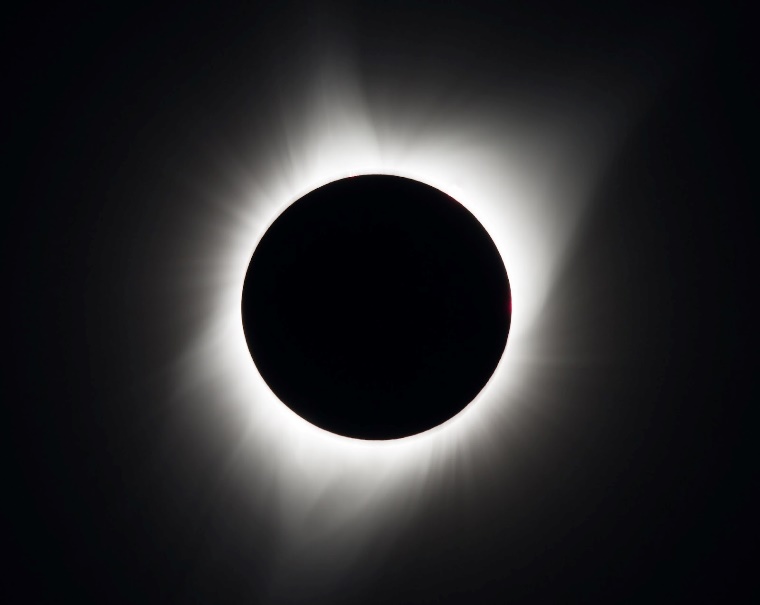Millions across North America await total solar eclipse
A total solar eclipse will have millions of people across a heavily populated swath of North America gazing toward the heavens on Monday as the moon completely blocks the sun for more than four minutes in some places.

A total solar eclipse will have millions of people across a heavily populated swath of North America gazing toward the heavens on Monday as the moon completely blocks the sun for more than four minutes in some places. The eclipse will be viewable along a path starting in Mexico and then crossing through the United States and into Canada. (Reuters live coverage)
Eclipse fans, hoping for cloudless skies, are gathering in places along the "path of totality" including in upstate New York, where the total eclipse will occur shortly after 3 p.m. (1900 GMT). At the Frontier Town campground in North Hudson, New York, children ran around wearing eclipse T-shirts, while parents set up tables, chairs and beer coolers.
Connecticut residents Bob and Teresa Love were stretched out in the cargo bed of their pickup truck, eating pastries and hoping the forecasted clouds hold off long enough to see the show. "I'm trying not to get too excited because of weather, just trying to keep expectations real," said Teresa, 49. "Some people say it's life-changing. I don't know if it's going to be life-changing, but I think it's going to be cool to see."
Michael Zeiler, a veteran eclipse chaser from New Mexico who already has witnessed 11 total eclipses across the globe, planned to watch the event from the city of Fredericksburg in central Texas. "First-time viewers of a total eclipse will be gobsmacked by the sight," said Zeiler, a cartographer and amateur astronomer who created the Great American Eclipse website. "It will be a peak life experience."
At up to 4 minutes and 28 seconds, this one will last longer than the total eclipse that streaked across parts of the United States in 2017, which clocked in at up to 2 minutes and 42 seconds. According to NASA, total eclipses can last anywhere from 10 seconds to about 7-1/2 minutes. Some cities along the path of totality include: Mazatlan, Mexico; San Antonio, Austin and Dallas, Texas; Indianapolis, Indiana; Cleveland, Ohio; Erie, Pennsylvania; both Niagara Falls, New York, and Niagara Falls, Ontario, site of the famed waterfall, and Montreal, Quebec.
A partial eclipse will be visible in North America outside the path of totality. About 32 million people in the United States live within the path of totality, with federal officials predicting another 5 million people will travel to be there. Countless eclipse-watching events were being convened at bars, stadiums, fairgrounds and parks along the path of totality.
Along the main shopping street in Oswego, New York, stores were selling eclipse-themed cookies and T-shirts, while a nearby eclipse-themed stage stood ready to host bands for a block party. This will be the ninth total eclipse for Anthony Aveni, author of the book "In the Shadow of the Moon: The Science, Magic and Mystery of Solar Eclipses" and a professor emeritus of physics and astronomy, sociology and anthropology at Colgate University in Hamilton, New York.
"It's an interruption in nature's status quo," Aveni said. "And it's an interruption that takes your breath away." Experts have advised eclipse viewers to use protective solar glasses to prevent eye damage from looking at the sun with the naked eye. Only during the few minutes of totality can the sun can be safely viewed without such glasses, they said.
Overcast skies are among an eclipse-chaser's worst fears. The U.S. National Weather Services forecast as of Monday morning was for "a rapid untimely increase of clouds" in Southern Texas; less worrying "high thin clouds" for a swathe from Arkansas to the Midwest; and the clearest skies in northern New England. It will take about 80 minutes from the moment the moon first begins to cover the sun to the moment of totality, then another 80 minutes to complete the process in reverse.
Eclipse veterans have described the 15 minutes before totality as foreboding, with shadows becoming oddly crisp and sunshine assuming an eerie quality. In the seconds before totality, a phenomenon called "shadow bands" may appear – shimmering shadows on the ground, like those seen on the bottom of a swimming pool. The last remaining bit of brilliant sunlight before totality creates a "diamond ring effect" in which a single bright spot appears along the lunar edge even as the sun's atmosphere leaves a ring of light around the moon.
Aveni said each eclipse he has witnessed has inspired deep awe in everyone around him who saw it, igniting a sense of community. He said people frequently burst into tears and hug complete strangers. "No matter who you are or when you lived, the sight of an eclipse begins with fear," Aveni said. "The imagery shocks you. That fear is gradually transformed into awe and then into a sublime state."
(This story has not been edited by Devdiscourse staff and is auto-generated from a syndicated feed.)
ALSO READ
Excelia Business School launches a new Doctorate in Business Administration (DBA) aimed at experienced managers
Inter Milan on the cusp of Serie A glory with Milan derby victory
Russia's Bashneft protects refineries with anti-drone nets, RIA says
New cast members Domhnall Gleeson and Sabrina Impacciatore join ‘The Office’ follow-up series
Lok Sabha elections: PM Modi takes on Congress as he holds a series of rallies in Maharashtra, Karnataka










